weight MERCEDES-BENZ E-CLASS SALOON 2017 Owners Manual
[x] Cancel search | Manufacturer: MERCEDES-BENZ, Model Year: 2017, Model line: E-CLASS SALOON, Model: MERCEDES-BENZ E-CLASS SALOON 2017Pages: 497, PDF Size: 10.38 MB
Page 24 of 497
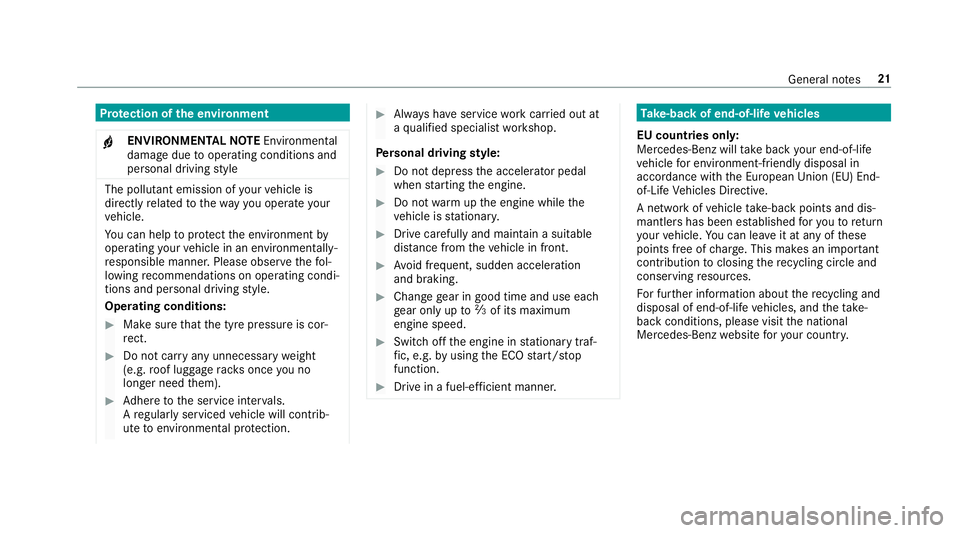
Pr
otection of the environment
+ ENVIRONMENTAL
NOTEEnvironmental
dama gedue tooperating conditions and
personal driving style The pollutant emission of
your vehicle is
directly related tothewa yyo u operate your
ve hicle.
Yo u can help toprotect the environment by
operating your vehicle in an environmentally-
re sponsible manner. Please obser vethefo l‐
lowing recommendations on ope rating condi‐
tions and pe rsonal driving style.
Operating conditions: #
Make sure that the tyre pressure is cor‐
re ct. #
Do not car ryany unnecessary weight
(e.g. roof luggage rack s once you no
lon ger need them). #
Adhere tothe service inter vals.
A regularly serviced vehicle will contri b‐
ute toenvironmen tal pr otection. #
Alw ays ha veservice workcar ried out at
a qu alified specialist workshop.
Pe rsonal driving style: #
Do not depress the accelera tor pedal
when starting the engine. #
Do not warm upthe engine while the
ve hicle is stationar y. #
Drive carefully and maintain a suitable
di st ance from theve hicle in front. #
Avoid frequent, sudden acceleration
and braking. #
Change gear in good time and use each
ge ar on lyup toÔ of its maximum
engine speed. #
Switch off the engine in stationary traf‐
fi c, e.g. byusing the ECO start/ stop
function. #
Drive in a fuel-ef ficient manne r. Ta
ke -back of end-of-life vehicles
EU countries onl y:
Mercedes-Benz will take back your end-of-life
ve hicle for environment-friendly disposal in
accordance with the European Union(EU) End-
of-Life Vehicles Directive.
A network of vehicle take -ba ckpoints and dis‐
mantlers has been es tablished foryo uto return
yo ur vehicle. You can lea veit at any of these
points free of charge . This makes an impor tant
contribution toclosing there cycling circle and
conse rving resources.
Fo r fur ther information about there cycling and
disposal of end-of-li fevehicles, and theta ke-
back conditions, please visit the national
Mercedes-Benz website foryo ur count ry. Gene
ral no tes 21
Page 45 of 497
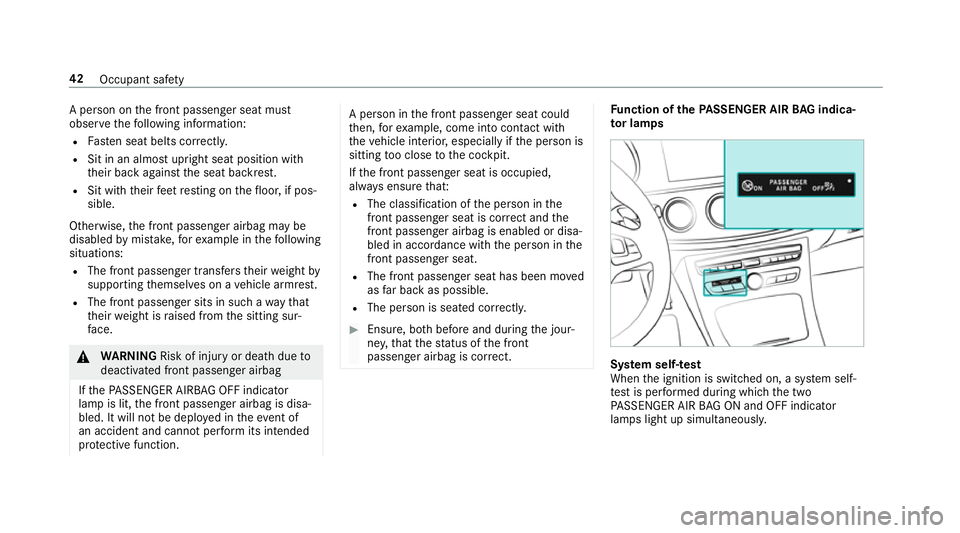
A pe
rson on the front passenger seat must
obser vethefo llowing information:
R Fasten seat belts cor rectl y.
R Sit in an almost up right seat position with
th eir back against the seat backrest.
R Sit with their feet resting on thefloor, if pos‐
sible.
Otherwise, the front passenger airbag may be
disabled bymis take ,fo rex ample in thefo llowing
situations:
R The front passen ger transfers their weight by
supporting themselves on a vehicle armrest.
R The front passenger sits in such a wayth at
th eir weight is raised from the sitting sur‐
fa ce. &
WARNING Risk of inju ryor death due to
deactivated front passenger airbag
If th ePA SSENGER AIRB AGOFF indicator
lamp is lit, the front passenger airbag is disa‐
bled. It will not be deplo yed in theeve nt of
an accident and cannot pe rform its intended
pr otective function. A person in
the front passenger seat could
th en, forex ample, come into con tact wi th
th eve hicle interior, especially if the person is
sitting too close tothe cockpit.
If th e front passenger seat is occupied,
alw ays ensure that:
R The classification of the person in the
front passenger seat is cor rect and the
front passenger airbag is enabled or disa‐
bled in accordance with the person in the
front passenger seat.
R The front passenger seat has been mo ved
as far back as possible.
R The person is seated cor rectl y. #
Ensu re, bo thbefore and during the jour‐
ne y,that thest atus of the front
passenger airbag is cor rect. Fu
nction of thePA SSENGER AIR BAG indica‐
to r lamps Sy
stem self- test
When the ignition is switched on, a sy stem self-
te st is per form ed during which the two
PA SSENGER AIR BAG ON and OFF indicator
lamps light up simultaneousl y.42
Occupant saf ety
Page 50 of 497
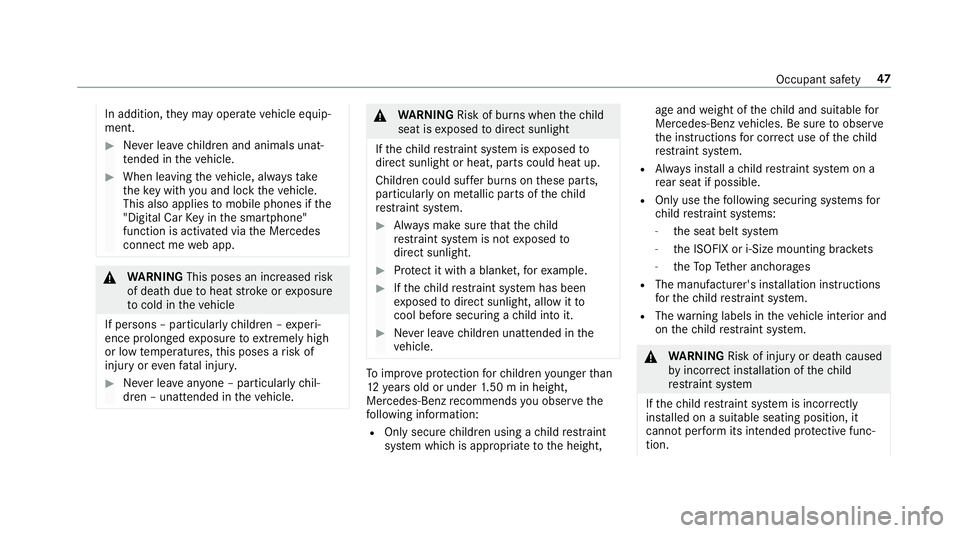
In addition,
they may operate vehicle equip‐
ment. #
Never lea vechildren and animals unat‐
te nded in theve hicle. #
When leaving theve hicle, alw aysta ke
th eke y with you and lock theve hicle.
This also applies tomobile phones if the
"Digital Car Key in the smartphone"
function is activated via the Mercedes
connect me web app. &
WARNING This poses an increased risk
of death due toheat strokeorexposure
to cold in theve hicle
If persons – particularly children – experi‐
ence prolonged exposure toextremely high
or low temp eratures, this poses a risk of
injury or evenfa ta l injur y. #
Never lea veanyone – pa rticularly chil‐
dren – unat tended in theve hicle. &
WARNING Risk of bu rns when thech ild
seat is exposed todirect sunlight
If th ech ild restra int sy stem is exposed to
direct sunlight or heat, parts could heat up.
Children could suf fer burns on these parts,
particularly on me tallic parts of thech ild
re stra int sy stem. #
Alw ays make sure that thech ild
re stra int sy stem is not exposed to
direct sunlight. #
Protect it with a blank et,fo rex ample. #
Ifth ech ild restra int sy stem has been
ex posed todirect sunlight, allow it to
cool before secu ring a child into it. #
Never lea vechildren unat tended in the
ve hicle. To
impr oveprotection forch ildren younger than
12 years old or under 1.50 m in height,
Mercedes-Benz recommends you obse rvethe
fo llowing information:
R Only secure children using a child restra int
sy stem which is appropriate tothe height, age and
weight of thech ild and suitable for
Mercedes-Benz vehicles. Be sure toobser ve
th e instructions for cor rect use of thech ild
re stra int sy stem.
R Alw ays ins tall a child restra int sy stem on a
re ar seat if possible.
R Onlyuse thefo llowing securing sy stems for
ch ild restra int sy stems:
- the seat belt sy stem
- the ISOFIX or i-Size mounting brac kets
- theTo pTe ther anchorages
R The manufacturer's ins tallation instructions
fo rth ech ild restra int sy stem.
R The warning labels in theve hicle interior and
on thech ild restra int sy stem. &
WARNING Risk of inju ryor death caused
by incor rect ins tallation of thech ild
re stra int sy stem
If th ech ild restra int sy stem is incor rectly
ins talled on a suitable seating position, it
cannot per form its intended pr otective func‐
tion. Occupant saf
ety47
Page 52 of 497
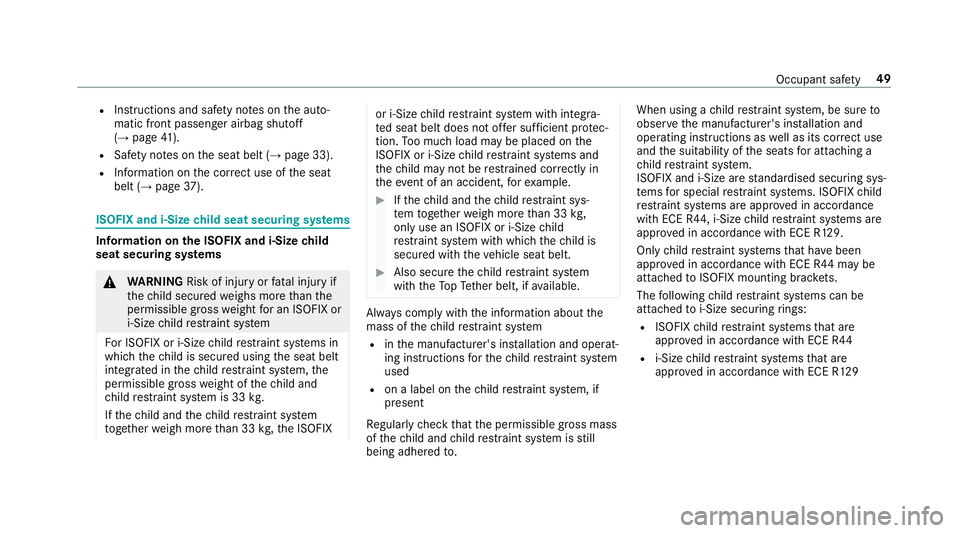
R
Instructions and saf ety no tes on the auto‐
matic front passenger airbag shutoff
(→ page 41).
R Safety no tes on the seat belt (→ page 33).
R Information on the cor rect use of the seat
belt (→ page37). ISOFIX and i-Size
child seat securing sy stems Information on
the ISOFIX and i-Size child
seat securing sy stems &
WARNING Risk of inju ryor fata l injury if
th ech ild secured weighs more than the
permissible gross weight for an ISOFIX or
i‑Size child restra int sy stem
Fo r ISOFIX or i‑Size child restra int sy stems in
which thech ild is secured using the seat belt
integrated in thech ild restra int sy stem, the
permissible gross weight of thech ild and
ch ild restra int sy stem is 33 kg.
If th ech ild and thech ild restra int sy stem
to ge ther we igh more than 33 kg,th e ISOFIX or i‑Size
child restra int sy stem with integra‐
te d seat belt does not of fer suf ficient pr otec‐
tion. Too much load may be placed on the
ISOFIX or i‑Size child restra int sy stems and
th ech ild may not be restra ined cor rectly in
th eeve nt of an accident, forex ample. #
Ifth ech ild and thech ild restra int sys‐
te m toget her weigh more than 33 kg,
only use an ISOFIX or i‑Size child
re stra int sy stem with which thech ild is
secured with theve hicle seat belt. #
Also secure thech ild restra int sy stem
with theTo pTe ther belt, if available. Alw
ays comply with the information about the
mass of thech ild restra int sy stem
R inthe manufacturer's ins tallation and operat‐
ing instructions forth ech ild restra int sy stem
used
R on a label on thech ild restra int sy stem, if
present
Re gularly check that the permissible gross mass
of thech ild and child restra int sy stem is still
being adhered to. When using a
child restra int sy stem, be sure to
obser vethe manufacturer's ins tallation and
operating instructions as well as its cor rect use
and the suitability of the seats for attaching a
ch ild restra int sy stem.
ISOFIX and i-Size are standardised securing sys‐
te ms for special restra int sy stems. ISOFIX child
re stra int sy stems are appr oved in accordance
with ECE R44, i‑Size child restra int sy stems are
appr oved in accordance with ECE R129.
Only child restra int sy stems that ha vebeen
appr oved in accordance with ECE R44 may be
attached toISOFIX mounting brac kets.
The following child restra int sy stems can be
attached toi-Size securing rings:
R ISOFIX child restra int sy stems that are
appr oved in accordance with ECE R44
R i‑Size child restra int sy stems that are
appr oved in accordance with ECE R129 Occupant saf
ety49
Page 53 of 497
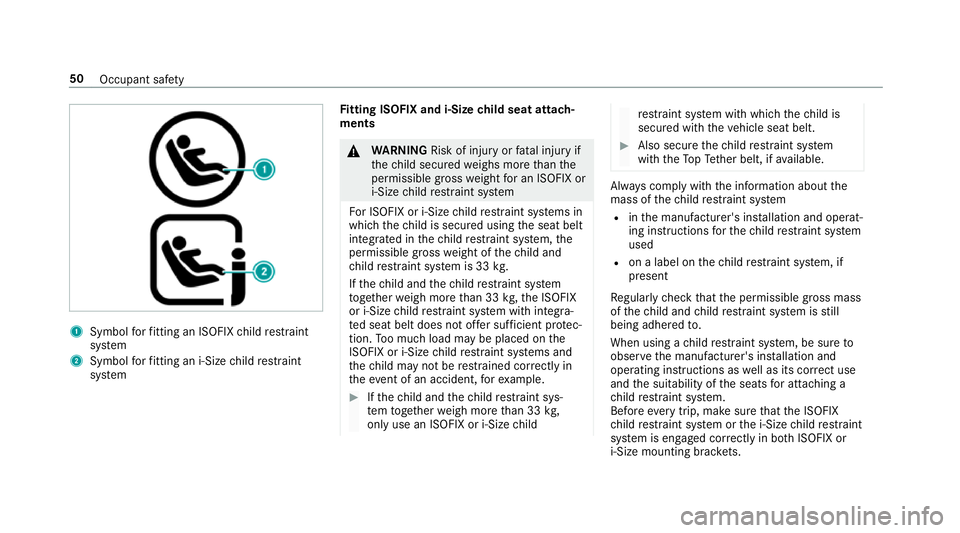
1
Symbol forfitting an ISOFIX child restra int
sy stem
2 Symbol forfitting an i-Size child restra int
sy stem Fi
tting ISOFIX and i-Size child seat attach‐
ments &
WARNING Risk of inju ryor fata l injury if
th ech ild secured weighs more than the
permissible gross weight for an ISOFIX or
i‑Size child restra int sy stem
Fo r ISOFIX or i‑Size child restra int sy stems in
which thech ild is secured using the seat belt
integrated in thech ild restra int sy stem, the
permissible gross weight of thech ild and
ch ild restra int sy stem is 33 kg.
If th ech ild and thech ild restra int sy stem
to ge ther we igh more than 33 kg,th e ISOFIX
or i‑Size child restra int sy stem with integra‐
te d seat belt does not of fer suf ficient pr otec‐
tion. Too much load may be placed on the
ISOFIX or i‑Size child restra int sy stems and
th ech ild may not be restra ined cor rectly in
th eev ent of an accident, forex ample. #
Ifth ech ild and thech ild restra int sys‐
te m toget her weigh more than 33 kg,
only use an ISOFIX or i‑Size child re
stra int sy stem with which thech ild is
secured with theve hicle seat belt. #
Also secure thech ild restra int sy stem
with theTo pTe ther belt, if available. Alw
ays comply with the information about the
mass of thech ild restra int sy stem
R inthe manufacturer's ins tallation and operat‐
ing instructions forth ech ild restra int sy stem
used
R on a label on thech ild restra int sy stem, if
present
Re gularly check that the permissible gross mass
of thech ild and child restra int sy stem is still
being adhered to.
When using a child restra int sy stem, be sure to
obser vethe manufacturer's ins tallation and
operating instructions as well as its cor rect use
and the suitability of the seats for attaching a
ch ild restra int sy stem.
Before everytrip, ma kesure that the ISOFIX
ch ild restra int sy stem or the i-Size child restra int
sy stem is engaged cor rectly in bo thISOFIX or
i‑Size mounting brac kets. 50
Occupant sa fety
Page 59 of 497
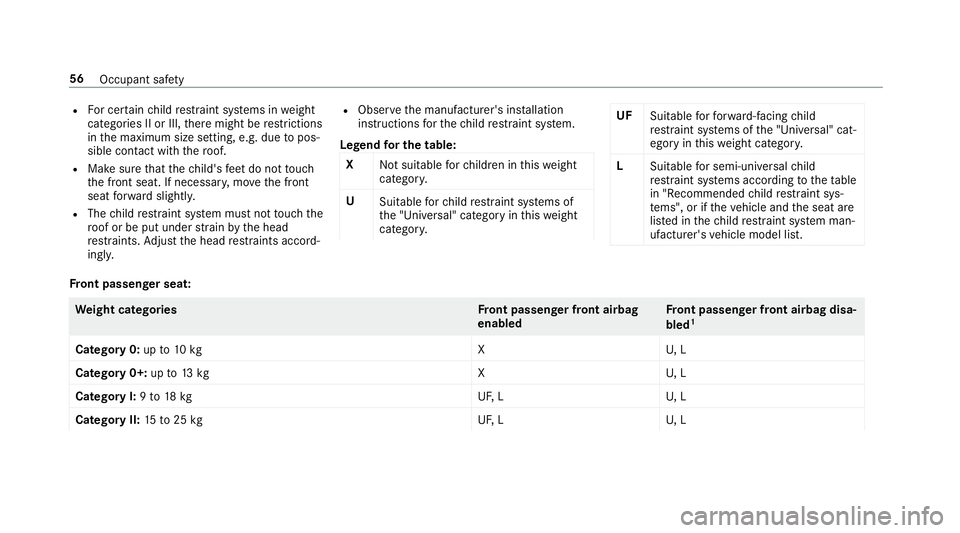
R
For cer tain child restra int sy stems in weight
categories II or III, there might be restrictions
in the maximum size setting, e.g. due topos‐
sible con tact wi th thero of.
R Make sure that thech ild's feet do not touch
th e front seat. If necessar y,mo vethe front
seat forw ard slightl y.
R The child restra int sy stem must not touch the
ro of or be put under stra in by the head
re stra ints. Adjust the head restra ints accord‐
ing ly. R
Obser vethe manufacturer's ins tallation
instructions forth ech ild restra int sy stem.
Legend for the table:
X Not suitable forch ildren in this we ight
categor y.
U Suitable forch ild restra int sy stems of
th e "Universal" category in this we ight
categor y. UF
Suitable forfo rw ard-facing child
re stra int sy stems of the "Universal" cat‐
egory in this we ight categor y.
L Suitable for semi-universal child
re stra int sy stems according totheta ble
in "Recommended child restra int sys‐
te ms", or if theve hicle and the seat are
lis ted in thech ild restra int sy stem man‐
ufacturer's vehicle model list. Fr
ont passenger seat: We
ight categories Front passenger front airbag
enabled Fr
ont passenger front airbag disa‐
bled 1
Category 0: upto10 kg XU, L
Category 0+: upto13 kg XU, L
Category I: 9to 18 kg UF,LU , L
Category II: 15to25 kg UF,LU , L56
Occupant saf ety
Page 62 of 497
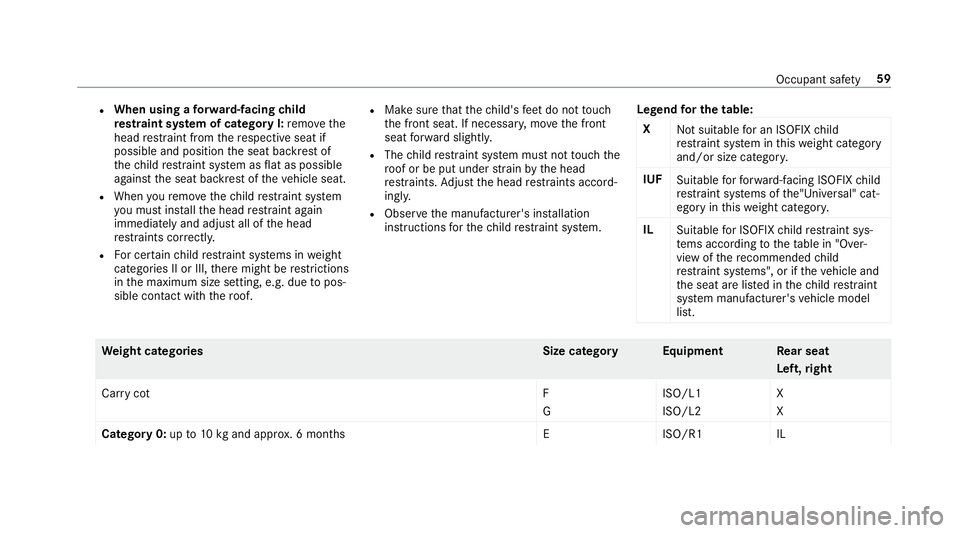
R
When using a forw ard-facing child
re stra int sy stem of category I: remo vethe
head restra int from there spective seat if
possible and position the seat backrest of
th ech ild restra int sy stem as flat as possible
against the seat backrest of theve hicle seat.
R When youre mo vethech ild restra int sy stem
yo u must ins tallth e head restra int again
immediately and adjust all of the head
re stra ints cor rectl y.
R For cer tain child restra int sy stems in weight
categories II or III, there might be restrictions
in the maximum size setting, e.g. due topos‐
sible con tact wi th thero of. R
Make sure that thech ild's feet do not touch
th e front seat. If necessar y,mo vethe front
seat forw ard slightl y.
R The child restra int sy stem must not touch the
ro of or be put under stra in by the head
re stra ints. Adjust the head restra ints accord‐
ing ly.
R Obser vethe manufacturer's ins tallation
instructions forth ech ild restra int sy stem. Legend
for the table:
X Not suitable for an ISOFIX child
re stra int sy stem in this we ight category
and/or size categor y.
IUF Suitable forfo rw ard-facing ISOFIX child
re stra int sy stems of the"Universal" cat‐
egory in this we ight categor y.
IL Suitable for ISOFIX child restra int sys‐
te ms according tothetab le in "Over‐
view of there commended child
re stra int sy stems", or if theve hicle and
th e seat are lis ted in thech ild restra int
sy stem manufacturer's vehicle model
list. We
ight categories Size categoryEquipment Rear seat
Left ,ri ght
Car rycotF
GISO/L1
ISO/L2X
X
Category 0:up to10 kgand appr ox. 6 months EISO/R1I L Occupant saf
ety59
Page 64 of 497
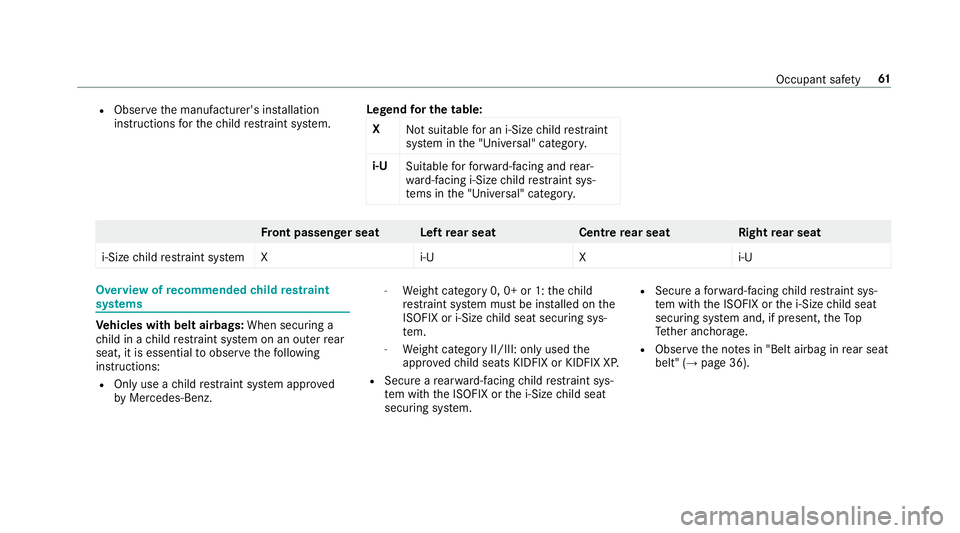
R
Obser vethe manufacturer's ins tallation
instructions forth ech ild restra int sy stem. Legend
for the table:
X Not suitable for an i-Size child restra int
sy stem in the "Universal" categor y.
i‑U Suitable forfo rw ard-facing and rear‐
wa rd-facing i-Size child restra int sys‐
te ms in the "Universal" categor y. Fr
ont passenger seat Left rear seat Centrerear seat Rightrear seat
i‑Size child restra int sy stem Xi ‑UXi ‑UOverview of
recommended child restra int
sy stems Ve
hicles with belt airbags: When securing a
ch ild in a child restra int sy stem on an outer rear
seat, it is essential toobser vethefo llowing
instructions:
R Only use a child restra int sy stem appr oved
by Mercedes-Benz. -
Weight category 0, 0+ or 1: thech ild
re stra int sy stem must be ins talled on the
ISOFIX or i-Size child seat securing sys‐
te m.
- Weight category II/III: only used the
appr ovedch ild seats KIDFIX or KIDFIX XP.
R Secure a rear wa rd-facing child restra int sys‐
te m with the ISOFIX or the i-Size child seat
securing sy stem. R
Secure a forw ard-facing child restra int sys‐
te m with the ISOFIX or the i-Size child seat
securing sy stem and, if present, theTo p
Te ther anchorage.
R Obser vethe no tes in "Belt airbag in rear seat
belt" (→ page 36). Occupant saf
ety61
Page 247 of 497
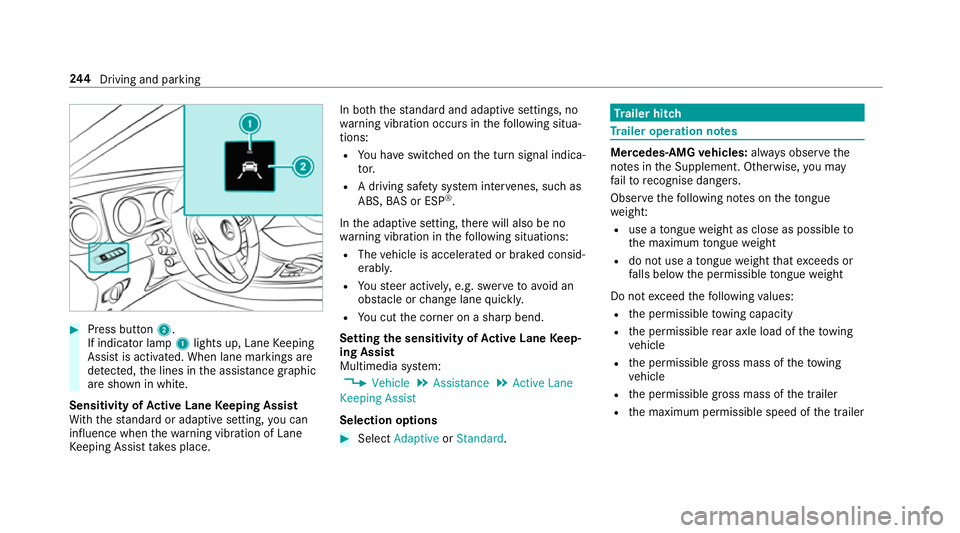
#
Press button 2.
If indicator lamp 1lights up, Lane Keeping
Assist is activated. When lane markings are
de tected, the lines in the assis tance graphic
are shown in white.
Sensitivity of Active Lane Keeping Assist
Wi th th est andard or adaptive setting, you can
influence when thewa rning vibration of Lane
Ke eping Assist take s place. In bo
th thest andard and adaptive settings, no
wa rning vibration occurs in thefo llowing situa‐
tions:
R You ha veswitched on the turn signal indica‐
to r.
R A driving sa fety sy stem inter venes, su chas
ABS, BAS or ESP ®
.
In the adaptive setting, there will also be no
wa rning vibration in thefo llowing situations:
R The vehicle is accelerated or braked consid‐
erably.
R Yousteer actively, e.g. swer vetoavo id an
obs tacle or change lane quickl y.
R You cut the corner on a sharp bend.
Setting the sensitivity of Active Lane Keep‐
ing Assist
Multimedia sy stem:
, Vehicle .
Assistance .
Active Lane
Keeping Assist
Selection options #
Select Adaptive orStandard. Tr
ailer hitch Tr
ailer operation no tes Mercedes‑AMG
vehicles: always obser vethe
no tes in the Supplement. Otherwise, you may
fa ilto recognise dangers.
Obser vethefo llowing no tes on theto ngue
we ight:
R use a tongue weight as close as possible to
th e maximum tongue weight
R do not use a tongue weight that exc eeds or
fa lls below the permissible tongue weight
Do not exceed thefo llowing values:
R the permissible towing capacity
R the permissible rear axle load of theto wing
ve hicle
R the permissible gross mass of theto wing
ve hicle
R the permissible gross mass of the trailer
R the maximum permissible speed of the trailer 244
Driving and pa rking
Page 340 of 497
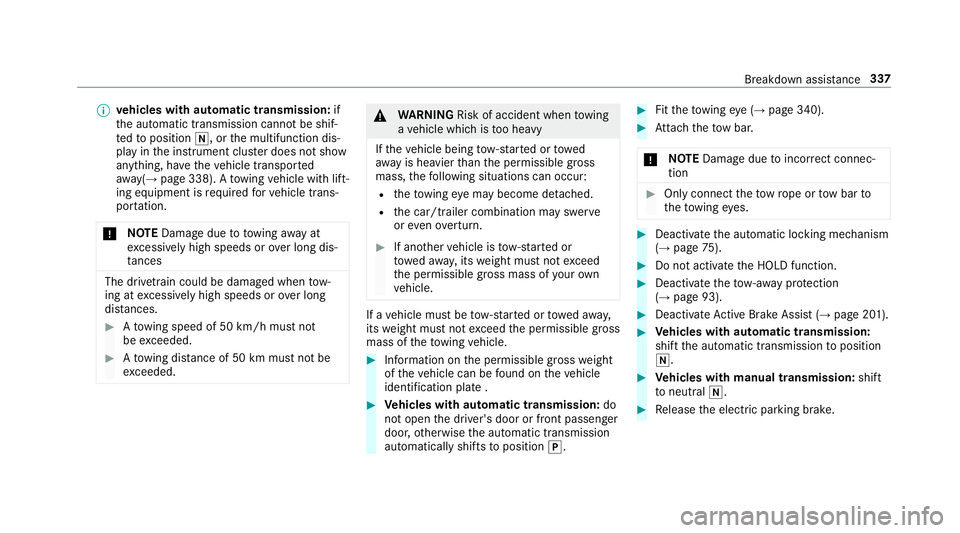
%
vehicles with automatic transmission: if
th e automatic transmission cann otbe shif‐
te dto position i, orthe multifunction dis‐
play in the instrument clus ter does not show
anything, ha vetheve hicle transpor ted
aw ay( →page 338). A towing vehicle with lift‐
ing equipment is requiredforve hicle trans‐
por tation.
* NO
TEDama gedue to to wing away at
exc essively high speeds or over long dis‐
ta nces The driv
etra in could be damaged when tow‐
ing at excessively high speeds or over long
dis tances. #
Atowing speed of 50 km/h must not
be exc eeded. #
Atowing dis tance of 50 km must not be
exc eeded. &
WARNING Risk of accident when towing
a ve hicle which is too heavy
If th eve hicle being tow- star ted or towed
aw ay is heavier than the permissible gross
mass, thefo llowing situations can occur:
R theto wing eye may become de tach ed.
R the car/t railer combination may swer ve
or eve nove rturn. #
If ano ther vehicle is tow- star ted or
to we daw ay, its weight must not exceed
th e permissible gross mass of your own
ve hicle. If a
vehicle must be tow- star ted or towe daw ay,
its weight must not exceed the permissible gross
mass of theto wing vehicle. #
Information on the permissible gross weight
of theve hicle can be found on theve hicle
identification plate . #
Vehicles with automatic transmission: do
not open the driver's door or front passenger
door, otherwise the automatic transmission
automatically shifts toposition j. #
Fittheto wing eye (→ page 340). #
Attach theto w bar.
* NO
TEDama gedue toincor rect connec‐
tion #
Only connect theto w rope or tow bar to
th eto wing eyes. #
Deactivate the automatic locking mechanism
(→ page 75). #
Do not activate the HOLD function. #
Deactivate theto w- aw ay protection
(→ page 93). #
Deactivate Active Brake Assi st (→page 201). #
Vehicles with automatic transmission:
shift the automatic transmission toposition
i. #
Vehicles with manual transmission: shift
to neutral i. #
Release the electric parking brake. Breakdown assis
tance 337